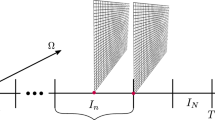Abstract
The aim of this work is to present an efficient parallel approach for the numerical computation of pulse propagation in nonlinear dispersive optical media. We consider the nonlinear Maxwell's equations associated with the modelization of the residual susceptibilities. The numerical approach is based on the finite difference time domain (FDTD) method, developed in a system of coordinates moving with the group velocity of the main pulse. In order to improve the computational delay, the size of the window is defined dynamically. However, for high frequencies pulses propagating in a large domain, the computational delay is still penalizing, particularly for 2D and 3D computations. Therefore the parallel technique is a way to develop an efficient approach. We present in this paper two parallel strategies, developed in the message passing framework. The first approach is based on a static load distribution and the associated communication structures are very simple. However, in this case the equivalent global load has been increased, compared to the optimal sequential computations. The second parallel approach preserves the global load of the optimal sequential computations. In this case, we have developed a load re-balancing strategy using specific communication structures. The parallel strategies are developed in the 1D case and their extension to multidimensional cases are straightforward. The efficiency of the parallel approaches is investigated with the computation of the second harmonic generation (SHG) in a KDP type crystal.
Similar content being viewed by others
References
S. A. Akhmanov, V. A. Vysloukh, and A. S. Chrirkin. Optics of Femptosecond Laser Pulses, American Institute of Physics, 1992.
H. J. Bakker, P. C. M. Planken, and H. G. Muller. Numerical calculation of optical frequencyconversion processes: A new approach. JOSA B, 6, 1989.
B. Bidégaray, A. Bourgeade, D. Reigner, and R. W. Ziolkowski. Multilevel Maxwell-Bloch simulations. In Proceeding of the Fifth International Conference on Mathematical and Numerical Aspects of Wave Propagation, pp. 221–225, 2000. July 10-14, Santiago de Compostela, Spain.
A. Bourgeade. Etude des propriétés de la phase d'un signal optique calculé avec un schéma aux différences finies de Yee pour un matériau linéaire ou quadratique, Preprint R-5913, CEA, Avril 2000.
A. Bourgeade and E. Freysz. Computational modeling of the second harmonic generation by solving full-wave vector Maxwell equations. JOSA, 17, 2000.
R. W. Boyd. Nonlinear Optics, Academic Press, 1992.
X. Carlotti and N. C. Kothari. Transient second-harmonic generation: Influence of the effective group-velocity dispersion. JOSA B, 5, 1988.
V. H. Cheryl and L. K. William. Numerical solutions of Maxwell's equations for nonlinear-optical pulse propagation. J. Opt. Soc. Am. B, 13:1135–1145, 1996.
T. Colin and B. Nkonga. Computing oscillatory waves of nonlinear hyperbolic systems using a phaseamplitude approach. In Proceeding of the Fifth International Conference on Mathematical and Numerical Aspects of Wave Propagation, p. 954, 2000. July 10-14, Santiago de Compostela, Spain.
B. Fidel, E. Heymann, R. Kastner, and R. W. Ziolkovski. Hybrid ray-FDTD moving window approach to pulse propagation. J. Comput. Phys., 138:480–500, 1997.
L. Gilles, S. C. Hagness, and L. Vazquez. Comparison between staggered and unstaggered finitedifference time-domain grids for few-cycle temporal optical soliton propagation. J. Comput. Phys., 16n1:379–400, 2000.
R. M. Joseph and A. Taflove. FDTD Maxwell's equations models for nonlinear electrodynamics and optics. IEEE Trans. Atennas and Propagation, 45, 1997.
A. C. Newell and J. V. Moloney. Nonlinear Optics, Addison-Wesley Publishing Company, 1991.
R. Maleck Rassoul, A. Ivanov, E. Freysz, A. Ducasse, and F. Hache. Second harmonic generation under phase and group velocity mismatch. Influence of cascading, self and cross phase modulations. Opt. Letters, 22, 1997.
P. G. Petropoulos. Numerical dispersion and absorbing boundary conditions. Int. J. Numer. Model., 13(5):483–498, 2000.
F. Rob Remis. On the stability of the finite-difference time-domain method. J. Comput. Phys., 163(1):249–261, 2000.
A. Taflove. Computational Electrodynamics: The Finite-Difference Time-Domain Method, Artech House, Norwood, MA, 1995.
K. S. Yee. Numerical solution of initial boundary value problems involving Maxwell's equations in isotropic media. IEEE Trans. Atennas and Propagation, 14:302–307, 1966.
D. W. Zingg, H. Lomax, and H. M. Jurgens. High-accuracy finite-difference schemes for linear wave propagation. SIAM J. Sci. Comput., 17(2):328–346, 1996.
W. D. Zingg. Comparison of high-accuracy finite-difference methods for linear wave propagation. SIAM J. Sci. Comput., 22(2):476–502, 2000.
Rights and permissions
About this article
Cite this article
Bourgeade, A., Nkonga, B. Dynamic Load Balancing Computation of Pulses Propagating in a Nonlinear Medium. The Journal of Supercomputing 28, 279–294 (2004). https://doi.org/10.1023/B:SUPE.0000022100.04162.86
Issue Date:
DOI: https://doi.org/10.1023/B:SUPE.0000022100.04162.86




